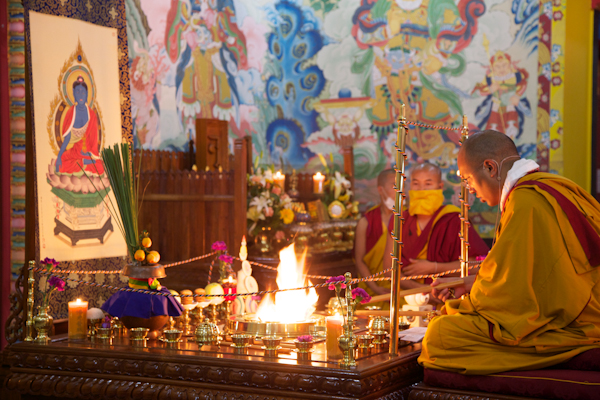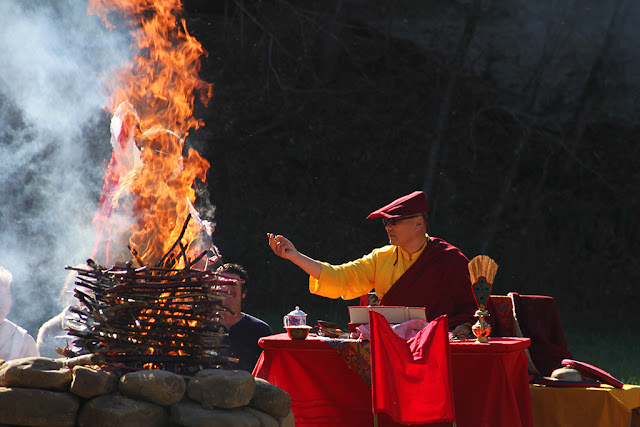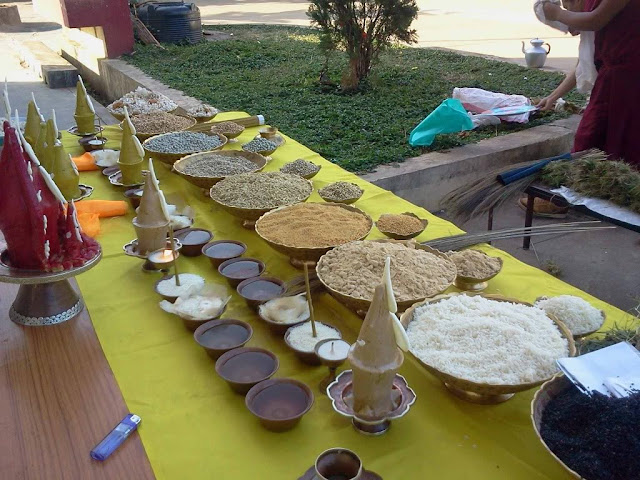Dharma wheel or "kore-low" in the Tibetan word. The golden wheel or Dharma wheel symbolizes the auspiciousness of the turning of the precious wheel of Buddha's doctrine, both in its teachings and realizations, in all realms and at all times, enabling beings to experience the joy of wholesome deeds and liberation.
This golden wheel is also called the Dharma chakra or the Dhamma chakka and is often used to represent Buddha himself. It has also universally become the symbol for Buddhism. The Dharma wheel has eight spokes, which represent Buddha’s Eightfold Path.
The Golden Dharma Wheel With A Pair of Deer
As Buddhists, when visiting a monastery, the first thing we see is a pair of male and female deer at either side of an eight-spokes Dharma wheel at then highest point of the monastery root.
Regarding the essential meaning of the Dharma wheel, from a historical perspective it is said to have been offered in the form of a thousand-spoke wheel to Buddha Shakyamuni by heavenly god Brahma when requesting Buddha to teach the sacred Dharma.
At that moment, from the forest came a pair of male and female deer, the deer is also commonly known as the "krishnasara antelope" of compassion. With unblinking gaze, the pair of deer looked at the wheel with joy and delight and subsequently, Shakyamuni Buddha related the noble eightfold path with the wheel.
Likewise, the Buddha related the male and female beings whose mind streams are touched by the path with the pair of deer. Ever since then, the golden Dharma wheel flanked by a pair of deer has been a special symbol for Buddhists.
The symbolism of the deer
The male (on the right) and female (on the left) deer represent both male and female disciples who one-pointedly enjoy and take pleasure in listening to the teachings of the sacred Dharma. The pair of deer represent skillful means and wisdom, Buddha hood can be attained.
The symbolism of the Dharma wheel
The eight-spokes wheel represents the first turning of the Dharma wheel by the Buddha Shakyamuni.The interior eight-spokes Dharma wheel represent the moral conduct of discipline from among the Three Trainings. The intermediate eight-spokes represent the training in wisdom and the noble eightfold path.
The outer eight-spokes Dharma wheel represent the training in samadhi or meditative concentration stage. The entirely of the Buddha's teachings are contained within the Three Trainings and noble eightfold path.
In brief, just as all the world's different religions and countries have their own symbols and insignia, the Dharma wheel with the pair of deer is the sign of Buddhism. Furthermore, this symbol was also the seal of the glorious Buddhist University of Nalanda in India long ago.
Thank you for reading, may you find peace and great bliss. With your support it helps to spread the Buddha’s precious teachings and turning the Dharma wheels in the world.
Aspiration For Bodhichitta
For those in whom the precious Bodhichitta has not arisen
May it arise and not decrease
But increase further and further.
Dedication of Merit
By this merit may we obtain omniscience then.
Having defeated the enemies wrong-doings.
May we liberate migratory from the ocean of existence.
With its stormy waves of birth, old age, sickness and death.
*Note
I do not own or infringe any copyright of these pictures.
Pictures courtesy and credit to the rightful distributors and or studios.
Pictures are intended for editorial use only.




































